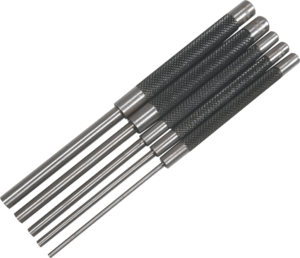Pin Punches: Difference between revisions
From DT Online
mNo edit summary |
(Added Template) |
||
| (One intermediate revision by one other user not shown) | |||
| Line 8: | Line 8: | ||
Usually parallel but available also slightly tapered as a [https://en.wikipedia.org/wiki/Drift_pin '''Drift Pin'''] to align holes together or as a specialised [https://en.wikipedia.org/wiki/Punch_(tool)#Spring_or_roll_pins '''Roll Pin Punch'''] designed to remove '''[[Pins and Clips|Roll Pins]]''' without damaging them. | Usually parallel but available also slightly tapered as a [https://en.wikipedia.org/wiki/Drift_pin '''Drift Pin'''] to align holes together or as a specialised [https://en.wikipedia.org/wiki/Punch_(tool)#Spring_or_roll_pins '''Roll Pin Punch'''] designed to remove '''[[Pins and Clips|Roll Pins]]''' without damaging them. | ||
{{Pin Punches Buyers Guide}} | |||
{ | |||
[[Category:Punches]] | [[Category:Punches]] | ||
Latest revision as of 12:59, 15 May 2016
Description
Pin Punches are also known as Drifts and are used to punch pins out of holes.
Features and Uses
Usually parallel but available also slightly tapered as a Drift Pin to align holes together or as a specialised Roll Pin Punch designed to remove Roll Pins without damaging them.
- The lowest cost option is to use a hand-held punch with a hammer but a wide range of automatic punches are available - both Dot Punches and Centre Punches.
- In general, Dot Punches have a sharper point (i.e. 60° instead of 90°) and need only the lower ranges of impact force (e.g. 20N to 50N).
- Automatic punches are simply pushed down against the work-piece and do not need to be struck - indeed, should NOT be struck with a hammer.
 |
 |
 |
 |
 |
 |
 |
| Centre Punch |
Automatic Centre Punch |
Bell Centre Punch |
Nail Punch |
Pin Punch |
Hollow Punch Set |
Number and Letter Punch Set |
